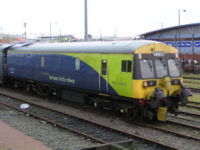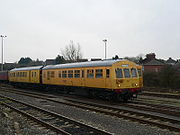
British Rail Class 901
Encyclopedia

British Rail
British Railways , which from 1965 traded as British Rail, was the operator of most of the rail transport in Great Britain between 1948 and 1997. It was formed from the nationalisation of the "Big Four" British railway companies and lasted until the gradual privatisation of British Rail, in stages...
Class 101
British Rail Class 101
The British Rail Class 101 diesel multiple units were built by Metro-Cammell at Washwood Heath in Birmingham from 1956 to 1959, following construction of a series of prototype units. This class proved to be the most successful and longest-lived of all BR's First Generation DMUs, with the final five...
diesel multiple unit
Diesel multiple unit
A diesel multiple unit or DMU is a multiple unit train consisting of multiple carriages powered by one or more on-board diesel engines. They may also be referred to as a railcar or railmotor, depending on country.-Design:...
s converted for departmental use. They were reclassified from the Class 960
British Rail Class 960
The British Rail Class 960 was reserved for former diesel multiple units converted for departmental use, and former electrical multiple units rebuilt as test trains...
series in early 2004 by their owner Network Rail
Network Rail
Network Rail is the government-created owner and operator of most of the rail infrastructure in Great Britain .; it is not responsible for railway infrastructure in Northern Ireland...
.
The two units are described below.
901001
This unit was converted in 1986 from a Class 101 power-twin unit. It was rebuilt as an Ultrasonic Test Train, replacing the former-Derby LightweightBritish Rail Derby Lightweight
The British Rail Derby Lightweight diesel multiple units, were the first such trains to be built en-masse for British Railways. The units were built at BR's Derby Works from 1954 to 1955. The units were built in various formations, including 12 power-twin 2-car units, 84 power-trailer 2-car units,...
unit that was previously used for this task. The unit was substantially rebuilt, including new headlight clusters, sealing of many windows, and later fitting of video and floodlight equipment for night-time use.
The unit also incorporates a heavily-modified former Class 432
British Rail Class 432
The British Rail 4-REP electric multiple units were built by BR at York Works from 1966-1967 and 1974. The units were built to power the 4-TC trailer units on services on the South Western Main Line. Fifteen four-car units were eventually built. The motor coaches were new build, but the trailers...
4Rep driving motor vehicle, which is now an intermediate trailer.
The Units Class 101 Power Cars are unique, as they are the only first generation DMU cars to have been converted to Air Brakes (both Westinghouse and Electro-Pnumatic). Most of the brake equipment came from former Class 50 Diesel Electric Locomotives, with some parts from ex-Southern Region EMU stock. All first generation DMU's were fitted with Vacuum Brakes from new.
The Power Cars DB 977391/392 are both now resident on the Churnet Valley Railway,for permeant way use. It is doubtful how much use the unit will get - as it is expensive to run. Both the units engines AND the units in-built generator unit need to be running - the generator provides a 240Vac supply for the battery charger and compressor (the units original engine driven air pumps would not be able to cope with air demand for Air brakes, air ep gear changing valves and the Air Conditioning units - which also require air.
In addition, special keys are required for the unit - which provide access to the doors, and only certain keys will fit the Drivers control switch.
There are also precious few Drivers who have experience of driving the unit with Air Brakes - although those that have say it is an exceptionally responsive train to drive, and can stop on a six-pence
| DM | T | DM | ||
|---|---|---|---|---|
| 977391 (ex-51433) | + | 999602 (ex-62483) | + | 977392 (ex-53267) |
The unit was originally painted in a unique silver and grey livery. This was replaced by Serco red/grey in the mid-1990s, followed by Railtrack
Railtrack
Railtrack was a group of companies that owned the track, signalling, tunnels, bridges, level crossings and all but a handful of the stations of the British railway system from its formation in April 1994 until 2002...
Blue/lime green and finally Network Rail's all-over yellow.
901002

British Rail Derby Lightweight
The British Rail Derby Lightweight diesel multiple units, were the first such trains to be built en-masse for British Railways. The units were built at BR's Derby Works from 1954 to 1955. The units were built in various formations, including 12 power-twin 2-car units, 84 power-trailer 2-car units,...
single-car unit.
It was used initially for radio survey work particularly with the National Radio Network (NRN) and later for video survey work including extensive signal sighting on the WCML prior to the introduction of 125 miles/h running.
| DM | DM | |
|---|---|---|
| 977692 (ex-53222) | + | 977693 (ex-53338) |
Like 901001, this unit has carried various liveries, starting with BR Research's silver and grey livery, similar to that carried by 901001. This was followed by Serco red/grey, Railtrack
Railtrack
Railtrack was a group of companies that owned the track, signalling, tunnels, bridges, level crossings and all but a handful of the stations of the British railway system from its formation in April 1994 until 2002...
Blue/lime green, and most recently the latest Network Rail
Network Rail
Network Rail is the government-created owner and operator of most of the rail infrastructure in Great Britain .; it is not responsible for railway infrastructure in Northern Ireland...
all-over yellow livery. This unit was withdrawn and stored at Derby's Railway Technical Centre
Railway Technical Centre
The Railway Technical Centre in London Road, Derby, UK, was built by the British Railways Board in the early 1960s to be its technical headquarters....
and was sold by Network Rail
Network Rail
Network Rail is the government-created owner and operator of most of the rail infrastructure in Great Britain .; it is not responsible for railway infrastructure in Northern Ireland...
to a private buyer in early 2008. It is now resident at Dunster station
Dunster railway station
Dunster railway station is near Dunster, Somerset, England and is on the West Somerset Railway, a heritage railway.-History:The station was opened on 16 July 1874 by the Minehead Railway. The line was operated by the Bristol and Exeter Railway which was also amalgamated into the Great Western...
on the West Somerset Railway
West Somerset Railway
The West Somerset Railway is a railway line that originally linked and in Somerset, England.It opened in 1862 and was extended from Watchet to by the Minehead Railway in 1874. Although just a single track, improvements were needed in the first half of the twentieth century to accommodate the...
, where it has been re-painted into BR green and will be used on Pway trains.

